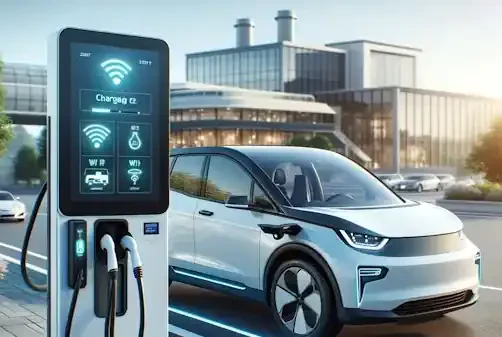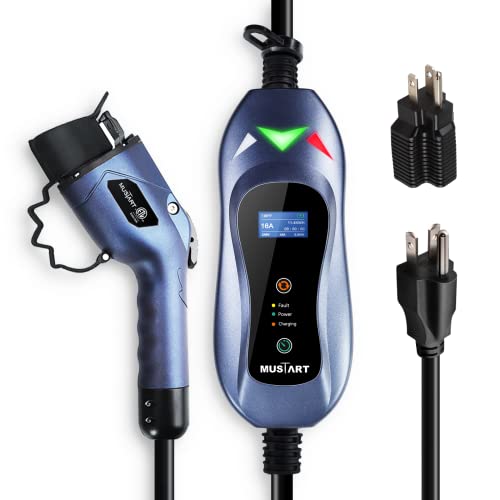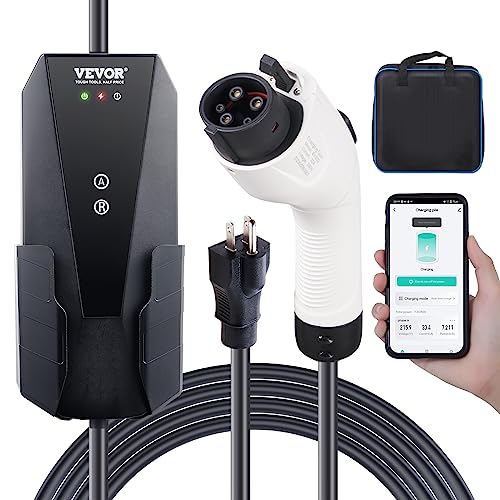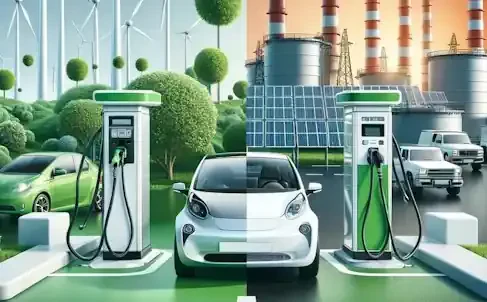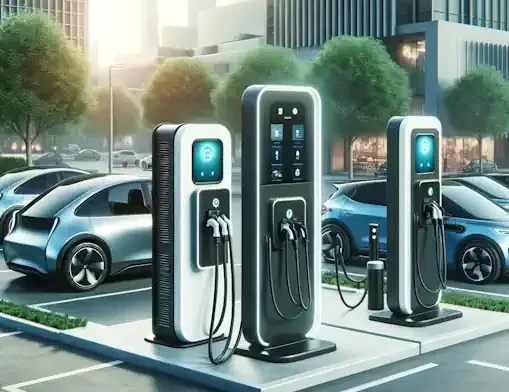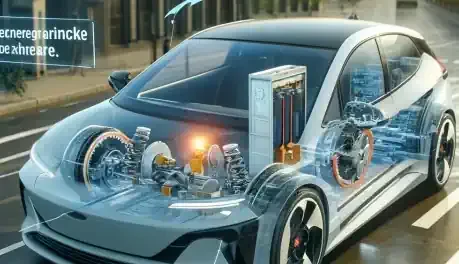Demystifying EV Charging Speeds: What You Need To Know
The world of EV charging can seem like a maze of acronyms and technical jargon. Understanding how quickly your electric vehicle (EV) can recharge is crucial for planning trips, managing daily commutes, and choosing the right charging solutions. This section breaks down the fundamentals of EV charging speed, empowering you to make informed decisions as an EV owner.
Why Understanding Charging Speed Matters For EV Owners
Charging speed isn't just about convenience; it's about maximizing your EV's potential. Whether you're embarking on a cross-country road trip or simply ensuring your daily errands are hassle-free, knowing how long it takes to replenish your battery is essential. Faster charging opens up new possibilities, expanding the range of destinations you can reach and minimizing downtime at charging stations.
The Key Factors That Influence EV Charging Time
EV charging time isn't a one-size-fits-all equation. Several factors interplay to determine how quickly your battery fills up:
Charger Type: The most significant factor is the type of charger you're using. Level 1, Level 2, and DC fast chargers each offer different power outputs, resulting in varying charging speeds.
Battery Size: The larger your EV's battery capacity, the longer it will naturally take to charge fully. Think of it like filling a bathtub versus a teacup.
State of Charge (SoC): If your battery is already partially charged, it will take less time to reach full capacity than if it were completely drained.
Charging Curve: EVs don't charge at a constant rate. Their charging curve typically starts fast and gradually slows down as the battery nears full capacity.
Ambient Temperature: Extreme temperatures, both hot and cold, can affect charging speeds. Batteries generally charge most efficiently in moderate temperatures.
Debunking Common Misconceptions About EV Charging
Several myths and misconceptions surround EV charging speeds. Let's set the record straight:
Myth: All EVs charge at the same speed.
Reality: Charging speeds vary significantly based on the EV model and the type of charger used.
Myth: You can only charge your EV at home.
Reality: A vast network of public charging stations is available, offering different charging speeds.
Myth: EV charging is always expensive.
Reality: While DC fast charging can be costly, Level 1 and Level 2 charging are often more affordable, especially at home.
Beyond Kilowatts: How Range And Battery Capacity Affect Charging
While kilowatts (kW) indicate a charger's power output, they don't tell the whole story. Your EV's range and battery capacity play a crucial role in determining charging time. A high-power charger may fill a smaller battery faster than a larger one, even if the kW rating is lower.
Tips For Estimating Your EV's Charging Time Accurately
Estimating charging time can be tricky due to the variables involved. However, several resources can help:
EV Manufacturer's Website: Check your EV's specifications for estimated charging times with different charger types.
Charging Station Apps: Many apps provide estimated charging times based on your EV model and the chosen charger.
Online Calculators: Several online tools can help you calculate charging time based on your specific parameters.
Level 1 Charging: The Basics And When It Makes Sense
Level 1 charging represents the most basic form of replenishing your EV's battery. While it might not be the fastest option, it's a practical and readily available solution for certain EV owners. This section unpacks everything you need to know about Level 1 charging, from its inner workings to its ideal use cases.
What Is Level 1 Charging And How Does It Work?
Level 1 charging utilizes a standard household electrical outlet (120 volts in North America). You simply plug your EV into a regular outlet using the provided charging cable. It's as easy as charging your phone or laptop. However, the lower voltage means that power transfer happens at a slower pace compared to other charging levels.
The Pros And Cons Of Using Level 1 Chargers
Like any charging option, Level 1 charging comes with its own set of advantages and disadvantages:
Pros:
Accessibility: Level 1 chargers are widely available since they utilize standard outlets found in most homes and garages.
Cost-Effective: No special equipment or installation is required, making Level 1 charging the most affordable option upfront.
Convenience: Plug in your EV overnight, and it's ready to go by morning.
Cons:
Slow Charging Speed: Level 1 charging is the slowest option available, adding roughly 2-5 miles of range per hour.
Limited Practicality: Not ideal for longer commutes or frequent driving due to the extended charging time.
Charging Cable Length: The standard cable might not always reach your desired parking spot, requiring some maneuvering.
Level 1 Charging Speeds: What To Expect In Real-World Scenarios
Level 1 charging typically adds 2-5 miles of range per hour, depending on your EV's model and battery size. To put it in perspective, if you drive 30 miles per day, it would take roughly 6-15 hours to fully recharge your EV using a Level 1 charger. This makes it more suitable for overnight charging when your vehicle is parked for an extended period.
Is Level 1 Charging Right For You? A Practical Assessment
Level 1 charging might be the perfect fit if you:
Have a short daily commute: If you only drive a few miles each day, the slower charging speed might not be a major inconvenience.
Rarely take long trips: For occasional longer journeys, you can rely on public charging stations with faster speeds.
Prioritize affordability: Level 1 charging eliminates the need for expensive equipment or installation costs.
Have access to a standard outlet: Ensure you have a convenient and accessible outlet near your parking spot.
Maximizing Level 1 Charging Efficiency: Tips And Tricks
While Level 1 charging is inherently slower, you can optimize its efficiency by following these tips:
Park in a garage: Protecting your EV from extreme temperatures can help maintain optimal charging conditions.
Use a dedicated circuit: Avoid overloading your electrical system by plugging your EV into a circuit not shared with other high-power appliances.
Monitor your charging: Keep an eye on your EV's charging progress using the vehicle's display or a smartphone app.
Unplug when fully charged: Avoid leaving your EV plugged in unnecessarily after it reaches full capacity.
Level 2 Charging: The Sweet Spot For Most EV Owners
Level 2 charging is the middle ground of EV charging speeds – faster than Level 1, but not quite as rapid as DC fast charging. For many EV owners, it strikes the perfect balance between convenience, speed, and affordability. This section delves into the ins and outs of Level 2 charging, making it your go-to guide for understanding this popular option.
Level 2 Chargers: A Comprehensive Overview
Level 2 chargers operate on a 240-volt circuit, similar to the one powering your electric dryer or oven. They deliver a significantly higher power output compared to Level 1 chargers, resulting in faster charging times. These chargers come in various forms, including:
Wall-Mounted Units: Installed on a wall in your garage or carport, these are the most common type for home charging.
Portable Chargers: These plug into a 240-volt outlet and offer flexibility for charging at different locations.
Public Charging Stations: Level 2 chargers are widely available at workplaces, shopping centers, and dedicated charging stations.
The Advantages Of Level 2 Charging For Everyday Use
Level 2 charging offers numerous benefits that make it a practical choice for many EV owners:
Faster Charging: Level 2 chargers can replenish your EV's battery significantly faster than Level 1, typically adding 10-60 miles of range per hour.
Home Charging Convenience: Installing a Level 2 charger at home allows you to charge overnight and wake up to a full battery every morning.
Public Charging Availability: Level 2 chargers are widely available in public charging networks, making it easy to top up your battery on the go.
Versatility: Portable Level 2 chargers offer flexibility for charging at different locations, such as vacation rentals or friend's houses.
Future-Proofing: As battery technology advances, Level 2 chargers are well-equipped to handle future EV models with larger battery capacities.
Level 2 Charging Speeds: A Detailed Breakdown
Level 2 charging speeds vary depending on several factors:
Charger Output: Chargers come in different amperage ratings, typically ranging from 16 to 48 amps. Higher amperage means faster charging.
EV's Onboard Charger: Your EV has a built-in charger that limits the amount of power it can accept. This varies between models.
State of Charge (SoC): Charging slows down as the battery nears full capacity.
On average, Level 2 chargers can add 10-60 miles of range per hour, translating to a full charge in 4-10 hours for most EVs.
Installing A Level 2 Charger At Home: Key Considerations
If you're considering a home Level 2 charger, keep these factors in mind:
Electrical Capacity: Ensure your electrical panel can handle the additional load of a Level 2 charger.
Permitting: Check local regulations for any permits required for installation.
Cost: Installation costs can vary depending on the complexity of the wiring and the charger model.
Location: Choose a convenient and accessible location for your charger.
Finding Public Level 2 Charging Stations: Essential Tips
Locating Level 2 chargers on the go is easier than ever. Here are some tips:
Utilize Charging Apps: Numerous smartphone apps can help you find nearby charging stations and check their availability.
Check Online Maps: Many websites and mapping services offer filters to locate EV charging stations.
Plan Ahead: Research charging station availability along your route before embarking on a long trip.
Consider Membership Networks: Some charging networks offer membership benefits like discounted rates or reserved charging slots.
DC Fast Charging: The Speed Demons Of The EV World
In the realm of EV charging, DC fast charging reigns supreme as the fastest way to replenish your electric vehicle's battery. Imagine recharging your car during a coffee break or a quick meal – that's the kind of speed DC fast charging offers. But what exactly is DC fast charging, and how does it work its magic? This section explores the intricacies of this high-speed charging technology, its advantages, drawbacks, and where you can find these charging stations.
Understanding DC Fast Charging Technology
Unlike Level 1 and Level 2 chargers, which deliver alternating current (AC) power that needs to be converted to direct current (DC) by the EV's onboard charger, DC fast chargers bypass this step. They directly supply DC power to the vehicle's battery, eliminating the need for conversion and significantly speeding up the charging process.
The Pros And Cons Of DC Fast Charging
DC fast charging brings a new level of convenience and speed to EV ownership, but it's important to weigh the pros and cons:
Pros:
Unmatched Speed: DC fast charging can add hundreds of miles of range in as little as 30 minutes, making it ideal for long road trips and quick top-ups.
Growing Network: The availability of DC fast chargers is rapidly expanding, with more stations popping up along major highways and in urban areas.
Reduced Downtime: Spend less time waiting for your EV to charge and more time enjoying your journey.
Stress-Free Travel: Knowing you can quickly recharge your EV provides peace of mind during long-distance travel.
Cons:
Higher Cost: DC fast charging is typically more expensive than Level 1 or Level 2 charging.
Potential Battery Degradation: Frequent DC fast charging might slightly accelerate battery degradation over time, although this effect is generally minimal.
Limited Availability Compared To Slower Chargers: While the network is growing, DC fast chargers are still less common than Level 2 chargers.
Not All EVs Are Compatible: Some older EV models may not be equipped for DC fast charging or may have lower charging speeds.
DC Fast Charging Speeds: A Deep Dive Into The Numbers
DC fast charging speeds are typically measured in kilowatts (kW). The most common types include:
50 kW Chargers: Can add approximately 100 miles of range in 30-60 minutes.
150 kW Chargers: Can add approximately 180 miles of range in 30 minutes.
350 kW Chargers: Can add up to 250 miles of range in just 15 minutes.
The actual charging speed will vary depending on your EV's battery capacity, state of charge, and the charger's maximum output.
Finding DC Fast Charging Stations: A Guide
Locating DC fast chargers is becoming increasingly easier:
Utilize Charging Apps: Several apps, like PlugShare and ChargeHub, can help you find nearby DC fast chargers and check their availability in real-time.
Consult Online Maps: Major mapping services like Google Maps and Apple Maps now include EV charging station filters, allowing you to pinpoint DC fast chargers.
Visit Manufacturer Websites: Some automakers provide online tools or apps to help locate compatible DC fast chargers for their EV models.
Maximizing DC Fast Charging Efficiency: Best Practices
To get the most out of your DC fast charging experience, consider these tips:
Precondition Your Battery: If possible, preheat or precool your battery before arriving at the charging station. This can help optimize charging speed.
Charge When Your Battery Is Low: The fastest charging typically occurs when the battery's state of charge is low.
Plan Your Stops: Research charging station locations along your route and plan stops strategically to minimize wait times.
Limit Time Spent At Peak Charge: Once your battery reaches around 80% charge, the charging speed will naturally slow down. Consider ending your session around this point to save time and avoid potential battery stress.
2x.Beyond The Basics: Emerging EV Charging Technologies
While Level 1, Level 2, and DC fast charging are the current mainstays of EV charging, the landscape is rapidly evolving. New and exciting technologies are emerging, promising to revolutionize how we power our electric vehicles. This section explores these cutting-edge developments, from Tesla's proprietary Superchargers to the promise of wireless charging and beyond.
Tesla Superchargers: The Gold Standard For Tesla Owners
Tesla's Supercharger network stands out as a beacon of innovation in the EV charging space. Designed exclusively for Tesla vehicles, these DC fast chargers offer unparalleled speed and convenience for Tesla owners. With charging speeds reaching up to 250 kW, Superchargers can replenish a significant portion of your Tesla's battery in a matter of minutes.
Exclusive Network: Tesla has built a vast network of Supercharger stations across the globe, strategically located along major highways and in popular travel destinations.
Seamless Integration: Tesla vehicles are designed to seamlessly integrate with Superchargers, automatically initiating charging and payment upon arrival.
On-Route Trip Planning: Tesla's navigation system intelligently routes you to Supercharger stations along your journey, ensuring you reach your destination with minimal charging stops.
V3 Superchargers: The latest generation of Superchargers boasts even faster speeds, with peak rates reaching 250 kW.
Future Expansion: Tesla continues to expand its Supercharger network, making long-distance travel in a Tesla even more convenient.
Wireless Charging: The Future Of EV Charging?
Imagine parking your EV and having it charge automatically without the need for cables or plugs. That's the promise of wireless charging. This technology utilizes electromagnetic fields to transfer energy between a charging pad on the ground and a receiver on the EV's undercarriage.
Convenience: Wireless charging eliminates the hassle of plugging and unplugging cables, making the charging process effortless.
Potential for Automation: Wireless charging could pave the way for autonomous vehicles to charge themselves without human intervention.
Reduced Wear and Tear: Eliminating physical connections can reduce wear and tear on charging ports and cables.
Challenges and Development: Wireless charging technology is still in its early stages, with challenges related to efficiency, cost, and standardization. However, several companies are actively developing and testing wireless charging solutions for EVs.
Extreme Fast Charging: Pushing The Boundaries Of Speed
The pursuit of faster charging speeds continues to drive innovation in the EV industry. Companies are developing extreme fast charging (XFC) technologies that aim to deliver unprecedented charging rates.
800-Volt Architectures: Some EV manufacturers are adopting 800-volt electrical architectures, enabling faster charging speeds compared to the standard 400-volt systems.
Megawatt Charging Systems (MCS): The development of MCS aims to achieve charging rates exceeding 1 megawatt (1000 kW), potentially adding hundreds of miles of range in just a few minutes.
Challenges and Potential: While XFC technologies hold great promise, challenges remain in terms of infrastructure requirements, battery safety, and cost.
Vehicle-To-Grid (V2G) Technology: A Game-Changer For EVs
V2G technology transforms EVs from mere consumers of electricity to potential power sources for the grid. When plugged in, V2G-enabled EVs can discharge power back to the grid during peak demand periods or emergencies.
Grid Stability: V2G can help stabilize the grid by balancing supply and demand, reducing the need for fossil fuel-powered peaker plants.
Financial Incentives: EV owners can potentially earn revenue by participating in V2G programs, offering a financial incentive to adopt this technology.
Technical Challenges and Pilot Programs: V2G technology is still in its early stages, with ongoing research and pilot programs exploring its potential benefits and challenges.
Smart Charging: Optimizing Your Charging Experience
Smart charging utilizes software and connectivity to optimize the charging process. It can schedule charging during off-peak hours when electricity rates are lower, integrate with renewable energy sources, and even prioritize charging for specific vehicles within a fleet.
Cost Savings: Smart charging can help EV owners reduce their electricity bills by taking advantage of time-of-use rates.
Grid Optimization: By shifting charging to off-peak hours, smart charging can help reduce strain on the electrical grid.
Integration with Renewable Energy: Smart charging can be integrated with solar panels or other renewable energy sources, maximizing the use of clean energy for charging.
The future of EV charging is bright, with innovative technologies promising to make charging faster, more convenient, and more sustainable.
EV Charging Infrastructure: Where We Stand And What's Next
As electric vehicles (EVs) continue to gain popularity, the need for a robust and reliable charging infrastructure is more pressing than ever. This section examines the current state of EV charging infrastructure, highlighting both the progress made and the challenges that lie ahead. We'll also explore the roles of various stakeholders, the impact of government policies, and the exciting innovations shaping the future of EV charging.
The Current State Of EV Charging Infrastructure
The EV charging landscape has seen remarkable growth in recent years. The number of charging stations has steadily increased, with options available for both home and public charging. Level 2 chargers are becoming increasingly common in homes, workplaces, and public spaces, while the network of DC fast chargers is expanding along major travel corridors.
Progress in Urban Areas: Major cities are leading the charge in deploying charging infrastructure, recognizing the need to support the growing number of EVs on their streets.
Highway Corridors: Efforts are underway to establish fast-charging corridors along major highways, facilitating long-distance travel for EV owners.
Workplace Charging: Many companies are installing charging stations at workplaces, incentivizing employees to adopt EVs and offering a convenient charging option during work hours.
Public-Private Partnerships: Collaboration between governments, utilities, and private companies is driving the expansion of charging networks.
Disparities in Availability: Despite progress, there are still disparities in charging infrastructure availability, with some regions and communities lagging behind.
Challenges And Opportunities In Expanding EV Charging Networks
Expanding EV charging infrastructure faces a number of challenges:
Cost: Building and maintaining charging stations, especially fast chargers, can be expensive.
Grid Capacity: The increasing demand for electricity from EVs can strain the existing power grid, requiring upgrades and investment.
Site Selection: Finding suitable locations for charging stations, particularly in urban areas with limited space, can be a challenge.
Standardization: Different charging standards and connector types can create confusion and compatibility issues for EV owners.
However, these challenges also present opportunities:
Technological Innovation: New charging technologies, such as wireless charging and extreme fast charging, can address some of the existing limitations.
Economic Growth: The expansion of EV charging infrastructure can stimulate economic activity and create jobs in the manufacturing, installation, and maintenance sectors.
Environmental Benefits: Widespread adoption of EVs, supported by adequate charging infrastructure, can significantly reduce greenhouse gas emissions and improve air quality.
The Role Of Governments And Utilities In EV Charging
Governments and utilities play a crucial role in shaping the future of EV charging:
Incentives and Regulations: Governments can incentivize the deployment of charging infrastructure through tax credits, rebates, and grants. They can also set standards and regulations to ensure safety and interoperability.
Utility Programs: Utilities can offer special rates and programs to encourage EV charging during off-peak hours, reducing strain on the grid and benefiting both EV owners and the utility.
Grid Upgrades: Utilities are investing in grid upgrades to accommodate the increasing demand for electricity from EVs.
Private Sector Initiatives Driving EV Charging Innovation
The private sector is also a major player in the EV charging space:
Charging Network Operators: Companies like ChargePoint, EVgo, and Electrify America are building and operating vast networks of charging stations.
Automakers: Many automakers are partnering with charging companies or developing their own charging solutions to support their EV models.
Technology Companies: Technology companies are developing innovative charging solutions, such as smart charging platforms and wireless charging systems.
The Future Of EV Charging Infrastructure: A Look Ahead
The future of EV charging infrastructure is promising, with several trends expected to shape its development:
Increased Density: The number of charging stations is expected to grow exponentially, with a focus on deploying chargers in underserved areas and along major travel routes.
Faster Charging: Advancements in technology will likely lead to even faster charging speeds, reducing charging times to minutes rather than hours.
Smart Charging: Smart charging solutions will become more prevalent, optimizing charging for cost savings and grid efficiency.
Wireless Charging: As technology matures, wireless charging could become a mainstream option, offering greater convenience and ease of use.
Integration with Renewable Energy: Charging stations will increasingly integrate with renewable energy sources, such as solar and wind power, to provide clean energy for EVs.
The continued expansion and evolution of EV charging infrastructure is essential to support the widespread adoption of electric vehicles and achieve a more sustainable transportation future.
Making Informed Choices: Selecting The Right EV Charger For You
Choosing the right EV charger is a crucial decision for every electric vehicle owner. The ideal charger aligns with your lifestyle, driving habits, budget, and charging needs. This section equips you with the knowledge and tools to navigate the vast landscape of EV chargers, ensuring you make a choice that keeps your EV powered up and ready for the road ahead.
Identifying Your Charging Needs: A Step-By-Step Guide
Before diving into the world of chargers, it's essential to assess your specific charging requirements:
Daily Driving Habits: How many miles do you typically drive each day? Do you mostly take short trips or frequent long journeys?
Home Charging Access: Do you have access to a garage or dedicated parking space where you can install a charger?
Charging Speed Preference: How quickly do you need to recharge your EV? Are you willing to wait for overnight charging, or do you require faster options for on-the-go top-ups?
Budget: What is your budget for purchasing and installing an EV charger? Keep in mind that Level 2 chargers generally cost more than Level 1 chargers, both in terms of the unit itself and installation.
Future Considerations: Do you anticipate upgrading to an EV with a larger battery capacity in the future? Choosing a charger that can accommodate future needs can save you money and hassle down the line.
Comparing Different Types Of EV Chargers: Key Features
EV chargers come in various shapes and sizes, each with its own set of features and benefits:
Level 1 Chargers: Ideal for occasional charging and those with short commutes, these chargers are affordable and easy to use but offer slower charging speeds.
Level 2 Chargers: The most popular choice for home charging, these chargers provide faster charging speeds and can fully recharge most EVs overnight.
DC Fast Chargers: These high-powered chargers are perfect for quick charging on the go, but they are typically more expensive and may not be suitable for daily home charging.
Portable Chargers: Offering flexibility for charging at different locations, portable chargers are convenient for travel but may have lower charging speeds.
When comparing chargers, consider factors like:
Power Output: Measured in kilowatts (kW), this determines the charging speed.
Amperage: Higher amperage typically means faster charging.
Cable Length: Choose a cable long enough to reach your EV's charging port comfortably.
Smart Features: Some chargers offer features like Wi-Fi connectivity, scheduling, and energy monitoring.
Safety Certifications: Ensure the charger is certified by a reputable organization like UL or ETL.
Cost Considerations For EV Chargers And Installation
The cost of an EV charger can vary widely depending on the type, brand, features, and installation requirements. Level 1 chargers are the most affordable, often costing less than $200. Level 2 chargers can range from $400 to $1,000 or more, depending on the power output and features. Additionally, installation costs for Level 2 chargers can range from a few hundred to several thousand dollars, depending on the complexity of the electrical work required.
Don't forget to factor in potential rebates or incentives. Many states and utility companies offer financial incentives for EV charger installation, which can significantly offset the upfront costs.
Top-Rated EV Charger Brands And Models
The market is flooded with EV charger options, but some brands consistently stand out for their quality, reliability, and innovation:
ChargePoint: Known for their wide range of charging solutions, including home and commercial chargers.
ClipperCreek: Offers reliable and durable Level 2 chargers for home and commercial use.
JuiceBox: Popular for their smart chargers with features like Wi-Fi connectivity and scheduling.
Grizzl-E: Provides high-power Level 2 chargers with rugged construction for extreme weather conditions.
Tesla Wall Connector: Tesla's own Level 2 charger, designed specifically for Tesla vehicles.
Research different brands and models, read reviews, and compare features to find the one that best suits your needs.
Getting The Most Out Of Your EV Charger: Expert Advice
Once you've chosen and installed your EV charger, follow these tips to maximize its benefits:
Regular Maintenance: Keep your charger clean and free of debris. Inspect cables and connectors for wear and tear.
Firmware Updates: Check for firmware updates from the manufacturer to ensure your charger is operating at peak efficiency.
Utilize Smart Features: If your charger has smart features, take advantage of them to schedule charging during off-peak hours and monitor energy usage.
Consider a Home Energy Management System: This can help you optimize your EV charging to reduce energy costs and maximize efficiency.
By carefully considering your charging needs, comparing different charger types, and following expert advice, you can confidently select the right EV charger and enjoy a seamless and convenient charging experience.
Summary
In this comprehensive exploration of EV charging speeds, we've demystified the factors that influence how quickly your electric vehicle replenishes its battery. Understanding charging speed is crucial for EV owners, impacting everything from daily commutes to cross-country road trips.
We've learned that various elements contribute to charging time, including the type of charger used, your EV's battery size, its current state of charge, and even the ambient temperature. We've also debunked common misconceptions, clarifying that not all EVs charge at the same rate and that charging isn't always expensive.
Furthermore, we've delved into the nuances of Level 1 charging, the most basic and accessible option utilizing standard household outlets. While Level 1 charging offers convenience and affordability, its slow speed limits its practicality for frequent or long-distance driving. However, for those with short commutes and access to a standard outlet, Level 1 charging can be a viable solution.
By understanding the factors that influence charging speeds and evaluating the pros and cons of different charging options, EV owners can make informed decisions that align with their driving habits, needs, and budget. Stay tuned for the next section, where we'll dive into the world of Level 2 charging and discover why it's considered the sweet spot for most EV owners.
